What injuries were sustained by people brought to hospitals from the streets, district police departments and Akrestsina, and how many were actually intoxicated
11 September 2020, 19:08 | TUT.BY
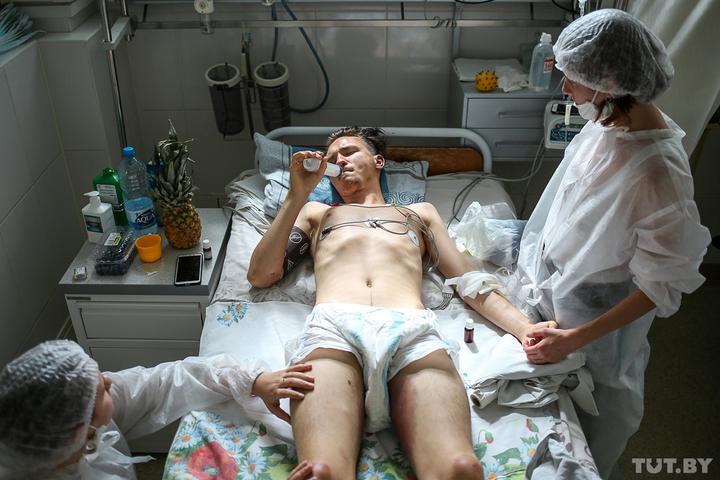
Source: Vadzim Zamirouski, TUT.BY
A few days ago, a document titled “Encounters streets_from 09.08.2020 onwards” was leaked to TUT.BY by sources in Belarusian healthcare. The document contains the personal data of more than 1,100 patients who sought medical attention since that time, as well as the evaluation of their injuries. TUT.BY has managed to verify the information based on feedback from five hospitals in Minsk – their data was found to be almost entirely consistent with the data in the document. Some hospitals gave us feedback which neither confirmed nor refuted the information, so the diagnoses which were made there are not quoted in this article. We would also like to reiterate that we received the document from unofficial sources.
The document comprises the lists of people who sought or received medical attention in a number of Minsk’s healthcare facilities from 9 to 23 August in the aftermath of “street events”.
It specifies the place and time of treatment, the preliminary diagnosis, where the patient was sent and the diagnosis made at the in-patient facility.
According to the document, approximately 1,140 people needed medical attention in Minsk during that time.
One “unidentified” person was pronounced “dead on arrival”, the document says. The person was probably Aliaksandr Taraikouski: the pick-up time and location specified in the document coincide with the circumstances of his death.
What injuries were recorded in patients who sought medical attention on the night of 9-10 August?
The document reveals that at least 100 people sustained injuries on 9-10 August in the country’s capital (i.e. in all Minsk hospitals, including those whose data we could not confirm). Ambulance crews spent the whole night picking them up and taking them to various hospitals. Those who suffered the most severe injuries were taken to the General Military Hospital.
That night, a few dozen people were admitted to the military hospital with shrapnel wounds to the face, chest, abdomen and limbs, lacerations, gunshot wounds, and burns to the upper limbs and the abdomen.
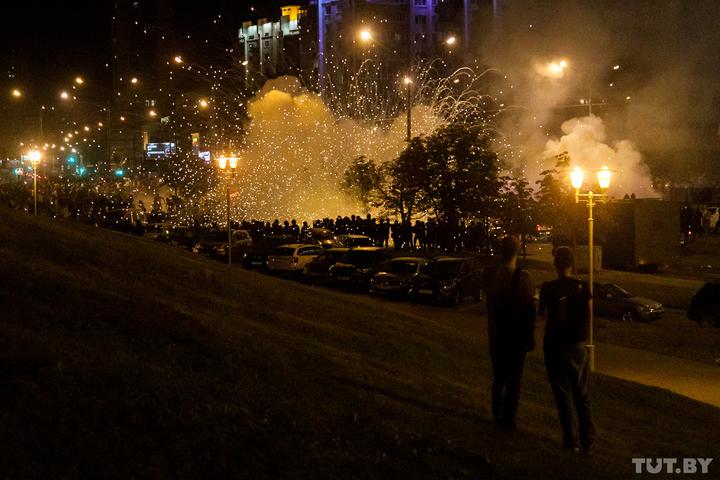
Source: Volha Shukaila, TUT.BY
Here is what some of the patients were diagnosed with:
- a penetrating abdominal injury and a herniation of the small intestine,
- an open chest injury and traumatic shock,
- a blast injury to the thigh, a moderate traumatic brain injury (TBI), and scalp contusions,
- shrapnel injuries to the neck and the right forearm,
- a penetrating shrapnel injury to the anterior triangle of the neck,
- chemical burns to the conjunctiva of both eyes,
- multiple gunshot wounds to the torso and a right lower limb,
- a laceration wound to each foot and a wound to the face.
According to the document, three people were reported to have suffered fractures of the base or vault of the skull that night as well. One of them had a comminuted fracture of the neurocranium (the base and vault of the skull), a fracture of the facial bones, pneumocephalus (an intracranial accumulation of air), a cerebral contusion, and a haematoma of the right frontal lobe. Those patients were purportedly taken to Minsk City Hospital No. 5, though we could not verify that.
Another person reportedly had a moderate open TBI, an acute subdural haematoma, a fracture of the neurocranium, pneumocephalus, a closed fracture of the 2nd to 7th ribs on the right, as well as a possible state of alcohol intoxication. He was taken to Minsk City Hospital No. 4.
What injuries were recorded in patients brought by ambulance from Akrestsina detention centre?
For some of the patients, the pick-up location was given as 36 1st Akrestsina Lane, which is the address of a detention centre run by the city’s police authority. According to the document, around 50 people were taken to hospital from there. The ambulance service received calls to that location from early in the morning on 10 August to 15 August (on 15 August, only one person was picked up at Akrestsina). Upon examination at healthcare facilities, doctors made a variety of diagnoses, the most common ones being multiple contusions of the soft tissues and the chest, thigh and gluteal haematomas, and contused wounds to the scalp over the parietotemporal region; less common injuries included broken ribs, arms and fingers, and a closed TBI.
Some of the detainees were admitted to hospital with a convulsive seizure or in a postictal state, with eye injuries, hypertensive crisis, and a closed displaced fracture of the right kneecap.
Two of the hospitalised Akrestsina detainees were found to have blood alcohol concentrations measuring 0.7 per mille and 3.3 per mille respectively. Another three patients were “possibly intoxicated”.
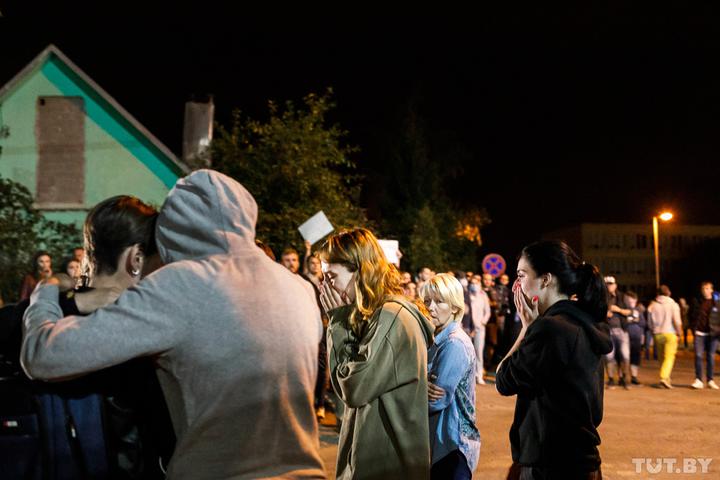
Source: Volha Shukaila, TUT.BY
If one takes a close look at the document, one will notice that in approximately five cases, various district police departments of Minsk are indicated as pick-up locations.
The document says, for instance, that on 10 August, two people were taken to hospital from the Leninski District Police Department: one with incised wounds to both thighs and the other in a state following electric shock. After visiting the hospital, they went home.
On the evening of 12 August, one person was taken to hospital from the Pershamaiski District Police Department with a closed TBI, a concussion, contusions of the scalp and lumbar region, and multiple lower limb haematomas.
In the early morning on 13 August, one person was picked up by an ambulance at the Leninski District Police Department with a closed TBI, a concussion, a contusion of the scalp over the right parietal region, and a broken nose.
On the night of August 13, one person was taken to hospital from the Partyzanski District Police Department following an epileptic seizure, with a closed TBI and a fracture of the roof of the maxillary sinus.
What happened after people began to be released from Akrestsina
According to the document, a large influx of calls was recorded on 14 and 15 August in the Minsk City Teaching Hospital No. 6. This was after detainees began to be released from Akrestsina on the night of 13-14 August.
The lists indicate that the injured persons went there on their own instead of by ambulance, and received treatment on an outpatient basis. During the two days in question, around 60 people sought medical attention at the hospital.
The most commonly reported injuries included chest contusions, thigh and gluteal haematomas, temporal scalp abrasions, abrasions to the wrist and knee joints, black eyes, joint contusions, closed TBIs, and healing fractures.
Patients at Minsk’s Hospital No. 11: fractures of the upper and lower jaw and cheekbone
According to the document, at least ten people went to Minsk City Teaching Hospital No. 11 or were admitted to its maxillofacial surgery and ENT departments from 11-21 August.
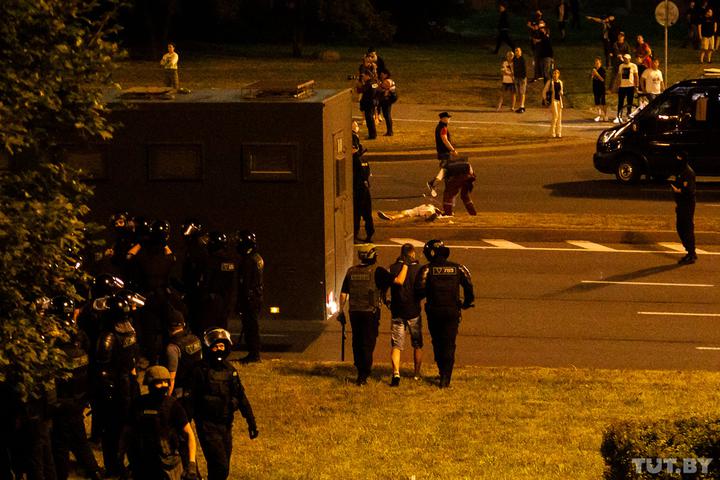
Source: Volha Shukaila, TUT.BY
Here are some of the diagnoses made at the facility:
- a fracture of the upper jaw and a contused wound to the face,
- an open traumatic fracture of a zygomatic bone (a cheekbone),
- a closed displaced traumatic fracture of the right zygomatic arch, a post-traumatic neuropathy of the V1 division of the right trigeminal nerve, and a right periorbital haematoma,
- an open non-displaced traumatic fracture of the anterior mandible (the front part of the lower jaw),
- an open displaced traumatic fracture of the right zygomatico-orbital complex,
- a lacerated, contused wound to the left eyebrow, haematomas of the left upper and lower eyelid, and a haematoma of the left superciliary arch,
- a traumatic perforation of the right tympanic membrane, abrasions to the right knee joint, and an incised wound to the popliteal region of the right leg.
What else?
One of the patients was reported to have suffered an avulsion (or degloving wound) to the right thigh, abrasion and contusion of soft tissues of the penis, and multiple abrasions to the lower limbs and the groin.
A patient at Minsk Emergency Care Hospital had suspected “damage to the rectal lining”.
29 people tested positive for ethanol. Another 31 people were deemed visibly intoxicated by a pre-hospital emergency physician or a doctor at an in-patient facility. As previously mentioned, the patient list comprises a total of 1,140 people.
The lists at TUT.BY’s disposal also include a law enforcement officer – he was tentatively diagnosed with a dislocation at the level of the wrist and hand. He received medical attention at the Belarusian Ministry of Internal Affairs hospital. One might recall that on 31 August, Minister of Internal Affairs Yury Karaieu said that his agency was aware of 131 officers having been injured during the August protests, with 28 of them remaining in hospital at the time.
On 9 September, TUT.BY requested for a comment on the issue from the press office at the Belarusian Ministry of Health, but did not receive a response at the time of publication on 11 September.
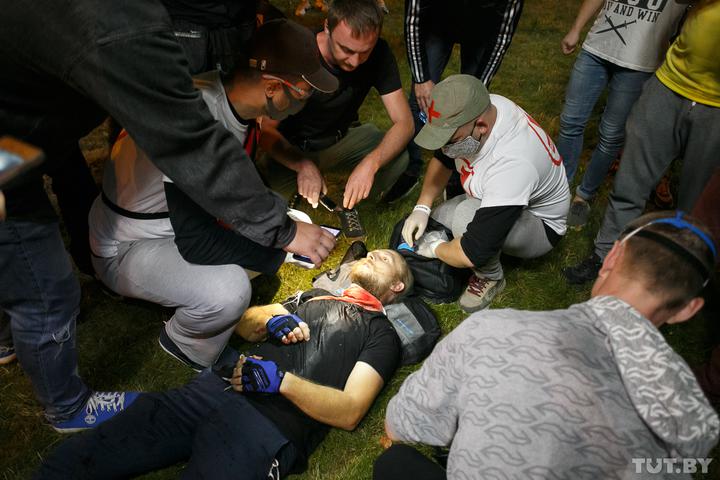
Source: Vadzim Zamirouski, TUT.BY
As previously mentioned, on 11 August, the Ministry of Health reported that just over 200 people were injured during the protests on 9-10 August. At the time, in-patient facilities saw people hospitalised with contusions of soft tissues and limb injuries.
“Several people were hospitalised with TBIs, as well as chest and abdominal injuries,” the Ministry reported. “Most of the injuries are mild. A few patients required surgery and were successfully stabilised. Unfortunately, one of the patients was found dead prior to being examined by emergency doctors.”
On 14 August, the agency’s public channel on Telegram (an instant messaging service) reported that most of the citizens who suffered injuries during the protests had received medical care as outpatients.
150 were receiving in-patient care in Belarusian hospitals at the time, the Ministry’s data suggested.
How we verified the authenticity of the document
First, we found on the lists the surnames of people whom we knew personally, had written about earlier, or people who had provided us with their medical documents. Their personal data given in the document was entirely consistent with what we knew.
We then contacted five hospitals for verification.
The staff at Minsk’s Hospital No. 11 responded that the patient list for their facility was entirely consistent with their records except for two people.
Minsk Teaching Hospitals No. 4 and 6 also confirmed the authenticity of the data, with the former remarking that there were minor discrepancies in the diagnoses and that one patient who had been seriously injured in the first days of the protests was missing from the list.
Minsk’s Emergency Care Hospital confirmed the authenticity of the data as well. It turned out, however, that some of the surnames on the list had been misspelled and that several patients actually had “more severe” diagnoses. The list also included a few patients who had reported themselves as injured in the protests but, in actual fact, were simply intoxicated. The rest of the data was identical to that provided by the hospital staff.
We also compared the data on injuries with which people were admitted to the military hospital. This information turned out to be identical as well.
According to the document, medical care was also provided to the injured by Minsk’s Hospitals No. 1, 2, 3, 5 and 10, the Republican Scientific and Practical Centre of Traumatology and Orthopaedics, Minsk Regional Teaching Hospital, and the Minsk Scientific and Practical Centre of Surgery, Transplantology and Haematology – there is some information about the number of patients admitted and the injuries they sustained which we were unable to verify definitely. Therefore, we avoided using this data unless its authenticity was proved by other sources such as the stories of people we have published earlier, provided that their personal data was consistent with that given in the document.